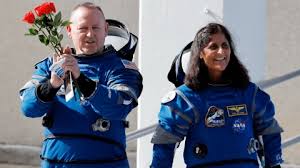
NASA has recently announced that astronaut Sunita Williams might not return to Earth until next year if the Boeing CST-100 Starliner spacecraft remains unsafe. This announcement has significant implications for both the future of the Starliner program and the operational schedule of NASA’s crewed missions. This article delves into the background of the Starliner program, the safety concerns impacting Sunita Williams’ return, and the broader implications for space travel.
Table of Contents
Background: The Boeing CST-100 Starliner Program Sunita Williams
Overview of Starliner:
- Spacecraft Purpose: The Boeing CST-100 Starliner is a spacecraft designed to transport astronauts to and from the International Space Station (ISS). It is part of NASA’s Commercial Crew Program, which aims to develop safe, reliable, and cost-effective crew transportation to the ISS.
- Development and Testing: The development of the Starliner has been a critical component of NASA’s strategy to reduce reliance on Russian Soyuz spacecraft for crew transportation. Boeing, a major aerospace manufacturer, has been working on Starliner for several years, with the goal of achieving operational capability and safety.
Previous Missions:
- Test Flights: Starliner has conducted several test flights, including an uncrewed test flight in December 2019. However, the mission experienced issues that prevented it from achieving its planned objectives. Subsequent test flights and reviews have focused on addressing these problems and ensuring spacecraft safety.
- Crewed Flights: The spacecraft was initially scheduled to commence regular crewed missions, but delays and safety concerns have impacted this timeline. The program’s progress has been closely monitored by NASA and industry experts.
Safety Concerns and Impact on Sunita Williams
Current Safety Status:
- Ongoing Issues: The Starliner program has encountered various safety and technical challenges. Issues such as software glitches, hardware problems, and other technical difficulties have been reported. These challenges have delayed the spacecraft’s readiness for crewed missions and raised concerns about its safety.
- NASA’s Assessment: NASA’s recent assessment indicates that if these safety issues are not resolved promptly, the spacecraft may remain unsuitable for crewed missions. This could impact the scheduled return of astronauts currently aboard the ISS, including Sunita Williams.
Sunita Williams’ Mission:
- Current Assignment: Sunita Williams is currently on a long-duration mission aboard the ISS. Her presence on the station is part of NASA’s strategy to maintain a continuous human presence in space and conduct important scientific research.
- Return Timeline: Due to the ongoing safety concerns with Starliner, Williams’ planned return to Earth has been postponed. If the spacecraft remains unsafe, her return might be delayed until next year, impacting her mission schedule and personal plans.
Implications for the Starliner Program
Program Delays:
- Operational Delays: The safety issues affecting Starliner have resulted in delays to its operational schedule. The postponement of crewed flights impacts NASA’s ability to rotate astronauts and conduct planned missions, affecting overall ISS operations.
- Cost Implications: Delays and safety issues may also lead to increased costs for the Starliner program. These costs include additional testing, modifications, and potential compensations for affected astronauts and mission schedules.
Program Reviews and Improvements:
- Technical Reviews: Boeing and NASA are conducting thorough reviews of the Starliner’s technical and safety issues. This includes addressing software and hardware problems, improving design and engineering processes, and enhancing overall spacecraft reliability.
- Safety Enhancements: Ensuring the safety of crewed missions is a top priority. The program’s focus on resolving safety concerns and implementing necessary improvements is critical for achieving operational readiness and maintaining trust in the spacecraft.
Broader Implications for Space Travel
Impact on NASA’s Commercial Crew Program:
- Alternative Solutions: NASA’s Commercial Crew Program includes other spacecraft, such as SpaceX’s Crew Dragon, which has successfully conducted crewed missions to the ISS. The continued reliance on alternative solutions highlights the importance of having multiple options for crew transportation.
- Partnerships and Collaboration: The success of NASA’s Commercial Crew Program relies on effective partnerships with private industry. Ensuring the reliability of all spacecraft involved is essential for maintaining the program’s goals and operational capabilities.
Astronaut Health and Well-being:
- Extended Missions: Prolonged missions aboard the ISS can impact astronauts’ health and well-being. Extended stays in space require careful management of physical and psychological health to ensure that astronauts remain fit for duty and able to perform their tasks effectively.
- Support Systems: NASA and its partners are responsible for providing comprehensive support to astronauts, including medical care, psychological support, and mission planning. Addressing delays and safety concerns is crucial for maintaining the well-being of crew members.
Future of Human Spaceflight:
- Innovation and Safety: The challenges faced by the Starliner program underscore the importance of innovation and safety in human spaceflight. Ongoing efforts to improve spacecraft design, testing procedures, and safety protocols are essential for the future of space exploration.
- Public and Industry Confidence: Ensuring the safety and reliability of crewed spacecraft is vital for maintaining public and industry confidence in space missions. Successful resolution of current issues will contribute to the credibility and success of future space endeavors.
Conclusion: Navigating Challenges and Ensuring Safety
NASA’s announcement regarding the potential delay of Sunita Williams’ return due to ongoing safety concerns with the Starliner spacecraft highlights the complexities and challenges of human spaceflight. The focus on resolving technical issues and ensuring the safety of crewed missions is paramount for the success of the Starliner program and the broader goals of space exploration.
As Boeing and NASA work to address these challenges, the broader space community remains engaged in monitoring progress and supporting efforts to enhance spacecraft safety and reliability. The resolution of current issues will be a critical step in achieving operational readiness for Starliner and ensuring the continued success of NASA’s Commercial Crew Program.
In the meantime, the commitment to astronaut safety, program improvement, and effective mission management will remain central to the ongoing efforts to advance human spaceflight and exploration. The successful resolution of these challenges will contribute to the future of space travel and the continued exploration of the cosmos.








